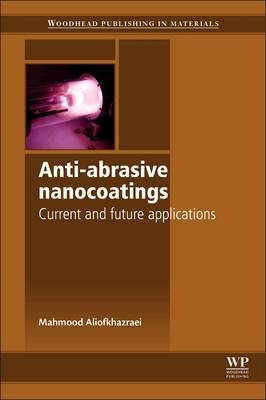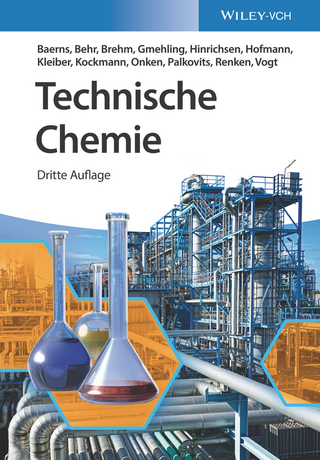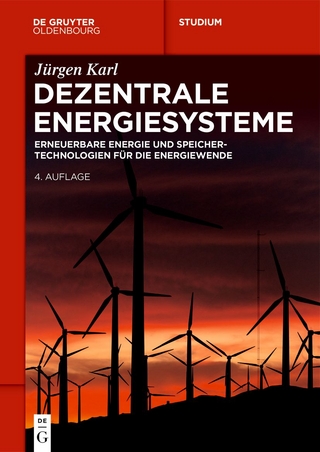
Anti-Abrasive Nanocoatings
Woodhead Publishing Ltd (Verlag)
978-0-85709-211-3 (ISBN)
Mahmood Aliofkhazraei is a PhD researcher in the Corrosion and Surface Engineering Group at the Tarbiat Modares University in Tehran, Iran. Having obtained his academic degrees from this university, his research has focussed on different aspects of nanocoatings. He is the author of over 50 scientific publications on nanocoatings and has received numerous scientific awards, including the Khwarizmi Award. In 2010, he was selected as the best young nanotechnologist nationwide. Mahmood is also a member of the National Association of Surface Sciences, Iranian Corrosion Association and the National Elite Foundation of Iran.
List of figures
List of tables
About the editor
About the contributors
Preface
Part One
1. Wear, friction and prevention of tribo-surfaces by coatings/nanocoatings
1.1 Introduction
1.2 Friction of materials
1.3 Wear in metals, alloys and composites
1.4 Materials and their selection for wear and friction applications
1.5 Coatings/nanocoatings and surface treatments
1.6 Conclusion
Acknowledgements
References
2. An investigation into the tribological property of coatings on micro- and nanoscale
2.1 Drivers of studying the origin of tribology behavior
2.2 Contact at nanometer scale
2.3 Atomic friction with zero separation
2.4 Scratching wear at atomic scale
2.5 Conclusion
References
3. Stress on anti-abrasive performance of sol-gel derived nanocoatings
3.1 Classical curvature stress for thin films on plate substrates
3.2 Thermal stress of thin films
3.3 Why do drying films crack?
3.4 Cracks by stress come from constraint of shrinkage by the substrate
3.5 Rapid sol-gel fabrication to confront tensile trailing cracks
3.6 Anti-abrasive SiO2 film in application: self-assembling covalently bonded nanocoating
3.7 Abrasive test
3.8 Anti-abrasive performance of sol-gel nanocoatings
3.9 Conclusion
Acknowledgments
References
4. Self-cleaning glass
4.1 Introduction
4.2 History of glass
4.3 Self-cleaning glass
4.4 Hydrophilic coating
4.5 Anti-reflective coating
4.6 Porous materials
4.7 Photocatalytic activity of TiO2
4.8 Hydrophobic coatings
4.9 Fabrication of self-cleaning glass
4.10 Application of self-cleaning glasses
Acknowledgements
References
5. Sol-gel nanocomposite hard coatings
5.1 Introduction
5.2 Sol-gel nanocomposite hard coatings
5.3 Mechanical property studies of sol-gel hard coatings on various substrates
5.4 Possible applications of hard coatings
5.5 Summary
Acknowledgments
References
6. Process considerations for nanostructured coatings
6.1 Overview
6.2 Anti-reflection coatings
6.3 Fluidized bed method
6.4 Electroplating
6.5 Nanografting
6.6 Plasma spray coating
6.7 Nanostructuring in thin films
6.8 Electrochemical deposition
6.9 Anti-corrosion coating
6.10 Infrared transparent electromagnetic shielding
6.11 Underlying science – self-assembly
6.12 Conclusions
References
Part Two
7. Nanostructured electroless nickel-boron coatings for wear resistance
7.1 Introduction
7.2 Synthesis of electroless nickel-boron coatings
7.3 Morphology and structure of electroless nickel-boron coatings
7.4 Mechanical and wear properties of nanocrystalline electroless nickel-boron coatings
7.5 Corrosion resistance
7.6 Conclusion
References
8. Wear resistance of nanocomposite coatings
8.1 Introduction
8.2 Materials and methods
8.3 Results and discussion
8.4 Conclusions
Acknowledgments
References
9. Machining medical grade titanium alloys using nonabrasive nanolayered cutting tools
9.1 Metallurgical Aspects
9.2 Machining of titanium alloys
9.3 Machining with coated cutting tools: a case study
9.4 Conclusions
Acknowledgments
References
10. Functional nanostructured coatings via layer-by-layer self-assembly
10.1 Introduction
10.2 LbL process
10.3 LbL-deposited nanostructured coatings with different functions
10.4 Conclusions
Acknowledgment
References
11. Theoretical study on an influence of fabrication parameters on the quality of smart nanomaterials
11.1 Introduction
11.2 Literature survey on VO2
11.3 Synthesis techniques description
11.4 Conclusion
References
12. Formation of dense nanostructured coatings by microarc oxidation method
12.1 Introduction
12.2 Phenomena of MAO-coating formation
12.3 Voltage–current characteristics
12.4 Discussion about growth mechanism of MAO coating
12.5 Model of fractal growth of the dense wear-resistant layer
12.6 Macro- and microstructure of MAO coatings
12.7 Wear-resistant properties
12.8 Conclusion
References
13. Current trends in molecular functional monolayers
13.1 Introduction
13.2 Steps for self-assembly
13.3 Mechanism
13.4 Characterization of SAMs
13.5 Use of SAMs for various applications
13.6 Self-assembled monolayers on gold substrates
13.7 Si-C monolayer formation and C-C bonding
13.8 Supramolecular assembly on surface–host-guest interactions and other non-covalent bonding
13.9 Self-assembled monolayers on other surfaces such as titania nanotubes
13.10 Chemical and electrical biosensors
13.11 Quality improvement
13.12 Conclusions
References
14. Surface engineered nanostructures on metallic biomedical materials for anti-abrasion
14.1 Introduction
14.2 Surface technologies on metallic biomedical materials for anti-abrasion
14.3 Future prospects
References
15. Theoretical modeling of friction and wear processes at atomic level
15.1 Introduction
15.2 MD method
15.3 Quantum chemistry methods
15.4 Basic types of problems
15.5 Lubrication and one-electron transfers
15.6 Conclusion
References
16. Mechanical characterization of thin films by depth-sensing indentation
16.1 Introduction
16.2 Hardness
16.3 Young’s modulus
16.4 Conclusion
Acknowledgements
References
Part Three
17. Advanced bulk and thin film materials for harsh environment MEMS applications
17.1 Introduction
17.2 Piezoelectric substrates
17.3 Non-piezoelectric substrates
17.4 Thin piezoelectric films
17.5 Metal electrodes
17.6 Conclusion
References
18. Plasma-assisted techniques for growing hard nanostructured coatings: An overview
18.1 Introduction
18.2 Hard nanocoatings: from history to designs and properties
18.3 Main plasma-based techniques for synthesis of hard nanocoatings
18.4 Conclusion
Acknowledgments
References
19. Thermal spray nanostructured ceramic and metal-matrix composite coatings
19.1 Introduction
19.2 Nanostructured feedstock
19.3 Nanostructured coatings
19.4 Proven applications
19.5 Possible future applications
19.6 Summary
Acknowledgements
References
20. Thermally sprayed nanostructured coatings for anti-wear and TBC applications: State-of-the-art and future perspectives
20.1 Introduction
20.2 Thermal spraying processes
20.3 Typical nanostructured coatings for technological applications
20.4 Conclusion
References
21. Hard thin films: Applications and challenges
21.1 Introduction
21.2 Characterization of thin films
21.3 Challenges
21.4 Summary
References
Index
| Erscheint lt. Verlag | 9.12.2014 |
|---|---|
| Verlagsort | Cambridge |
| Sprache | englisch |
| Maße | 152 x 229 mm |
| Gewicht | 1050 g |
| Themenwelt | Naturwissenschaften ► Chemie ► Technische Chemie |
| Technik ► Maschinenbau | |
| ISBN-10 | 0-85709-211-1 / 0857092111 |
| ISBN-13 | 978-0-85709-211-3 / 9780857092113 |
| Zustand | Neuware |
| Haben Sie eine Frage zum Produkt? |
aus dem Bereich


